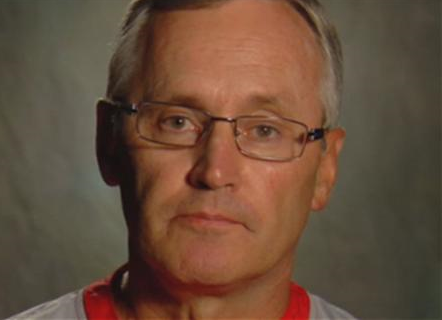 A coach.
A coach.I don't want to spend a lot of time on an extended epitaph for Jim Tressel (we'll have plenty of time for that), but I will say that when a man who has been the face of your favorite team in the world for your entire adult life and a couple of years of your semi-adult life abruptly resigns in the face of mounting criticism and scrutiny, it sucks. But as much as I liked Jim Tressel, I love Ohio State. The coach may be gone, but the university is still there. And there my heart lies.
Haven't read the Sports Illustrated article yet? Here, I'll save you 15 minutes:
Ohio State has conceded that six current players committed an NCAA violation by trading memorabilia for tattoos or cash at Fine Line Ink: Pryor, tackle Mike Adams, running back Dan Herron, wide receiver DeVier Posey, defensive end Solomon Thomas and linebacker Jordan Whiting. Ellis, who spent time in and around the tattoo parlor for nearly 20 months, says that in addition to those six, he witnessed nine other active players swap memorabilia or give autographs for tattoos or money. Those players were defensive back C.J. Barnett, linebacker Dorian Bell, running back Jaamal Berry, running back Bo DeLande, defensive back Zach Domicone, linebacker Storm Klein, linebacker Etienne Sabino, defensive tackle John Simon and defensive end Nathan Williams. Ohio State declined to make any of its current players available to respond to SI.
Based off of interviews from two anonymous former employees of Eddie Rife, Dustin Halko and a man called "Ellis" for the purpose of this article, it is the central issue for a number of reasons. First, there's basically no chance in hell that any NCAA investigator would be able to find something solid on alleged misconduct by players years after the fact based on the testimony of a convict. Actually, now that I type that out, it seems pretty unlikely that the aforementioned current players would be facing anything serious based on the content of this article alone, either. But the Jim Tressel and Ohio State story isn't, as far as we are concerned, about anything that happened five years ago, or ten years ago, or even an allegedly rigged raffle thirty years ago (the very idea of which makes me recoil in utter contempt and horror).
It is about known, provable violations by OSU football players and whether or not Jim Tressel endorsed them or had a reasonable expectation to know about and stop them.
The release of George Dohrmann's investigative report was met with a lot of apprehension among Buckeye fans, and understandably so. When I found out this morning that Tressel had resigned, my brain did the same leap of logic that most of us made, which was that Sports Illustrated has found some serious dirt on the coach and the coming article was going to make his resignation inevitable. To be fair, Jim Tressel was a lame duck at this point anyway. Those expecting him to last longer than the end of the coming season were probably kidding themselves, and given the rumored internal pressures he faced from donors and other influential members of the Ohio State family, him stepping down is not altogether a shock.
The timing was the concerning thing, though. Dohrmann surely had found something big to cause such an abrupt shift from "Jim Tressel has the full support of the athletic department" to "I am stepping down as head coach of Ohio State."
What we got was something different. The first two pages of SI's expose are mainly related to past allegations of misconduct and violations during Tressel's tenure, specifically the Maurice Clarett and Troy Smith issues. But as our own Ramzy pointed out on Twitter, not only is this old news, ESPN covered it pretty thoroughly seven years ago. In any case, the case that George Dohrmann and SI are attempting to make is the idea that
The Clarett and Baker scandals were further evidence that Tressel was, at best, woefully ignorant of questionable behavior by his players and not aggressive enough in preventing it. At worst, he was a conduit for improper benefits, as Clarett alleged.
Jim Tressel being "woefully ignorant of questionable behavior by his players" is certainly a possibility, and one that I'll address later. The other, much more damning accusation is that Tressel was directly involved in improper benefits, and to support this Dohrmann offers two anecdotes from Tressel's Youngstown days. The first is the Mickey Monus story described in the ESPN article, where Tressel is alleged to have set a player up with Monus, a local businessman, for a phony job where the player collected paychecks during the school year. The second is an anecdote from Ray Isaac, who claimed that sometimes parking tickets would "disappear" after completing a Jim Tressel punishment.
The veracity of both of these incidents are, of course, extremely difficult to determine (given how old they are). But more than that, they are completely irrelevant. There is no pay for play scandal described here in the current allegations, nor is there a phony jobs scheme or massive and repeated recruiting violations.
 There does seem to be a lot of players selling or trading memorabilia over the years. Dohrmann describes a situation where more than a few dozen players over the past ten years sold items to a shady tattoo parlor owner, and while the more sordid details involve Rife threatening former employee Dustin Halko with a gun and having him assaulted, the worst newly uncovered allegations leveled at players seem to be: more players getting tats for swag, Jermil Martin trading Rose Bowl tickets for a truck, Pryor selling gear, players eating chicken and playing PS3 a lot, and a for some reason unidentified player receiving a pound of marijuana.
There does seem to be a lot of players selling or trading memorabilia over the years. Dohrmann describes a situation where more than a few dozen players over the past ten years sold items to a shady tattoo parlor owner, and while the more sordid details involve Rife threatening former employee Dustin Halko with a gun and having him assaulted, the worst newly uncovered allegations leveled at players seem to be: more players getting tats for swag, Jermil Martin trading Rose Bowl tickets for a truck, Pryor selling gear, players eating chicken and playing PS3 a lot, and a for some reason unidentified player receiving a pound of marijuana.
All bad, and I'm not going to question the credibility of Ellis here; every team is going to have their fair share of Rob Roses and Ray Smalls who attempt to game the system. What has driven the largely dismissive reaction to this piece though isn't the lack of surprise that this kind of thing happened, it's the fact that nothing especially new was uncovered. The car scandal, thought to be the next step in this whole process, is barely mentioned. Aside from the weed, no real law was seemingly broken by players. And most importantly, no evidence, anecdotal or otherwise, is given that Tressel knew about any of this.
Which is really who Dohrmann's article is supposedly about. Dohrmann says that Jim Tressel is a coach who will "do whatever it takes to win," and the implication is that includes willfully ignoring violations over the years by his own players. And if true, that's a pretty serious charge. But I want to point out a few things:
- One of the quotes from Ray Small's interview with the Lantern that Dohrmann failed to cite was "(It) was kind of hush-hush. I mean, you tell … probably your close friend, or a close friend to your close friend... As far as everybody just talking about it in the locker room, that wasn't really a big thing. So if somebody is giving them a deal, it was probably a situation where they kept it to themselves." This does not seem to imply that the gear for tats deal was the open secret Dohrmann claims it was.
- From 2002 to present, the timeframe that Dohrmann gives for these violations, there have been hundreds of Ohio State football players. Dohrmann claims that 28 of them being involved with Eddie Rife is a "staggering" number, and while I would agree that it shows a pattern of misconduct in that regard, "staggering" is not the word I would use.
- Tressel's own, admittedly half assed, investigation into the situation also seems to discredit the idea that he knew beforehand. If he somehow did know of Eddie Rife for years and turned a blind eye to his player's involvement with him, then he deserves to be nailed to the wall for it, along with Ohio State. I don't believe this to be the case, however.
- No concrete proof can be given about any of the allegations, except through the pictures that Ellis provided SI, which show some of the players already known to be involved in the scandal, plus Thad Gibson, at Eddie Rife's business.
Ultimately the NCAA will have to make several determinations, most importantly of which is exactly how closely Jim Tressel should have been reasonably expected to know about these issues. If they feel that knowing about the violations with gear and memorabilia fall under that expectation, then Ohio State could be looking at the label of "lack of institutional control," "failure to monitor," and some pretty severe punishments.
On this, I'm torn. Any time there are violations that consistent, if relatively innocuous, there inherently exists a "failure to monitor" within a program. But to say that Ohio State has a "lack of institutional control" on the level of a USC, where agents and massive sums of money were being exchanged, is patently false and only hurts the vast majority of players who committed no violations.
Players did sell items in violation of NCAA rules, and once Jim Tressel found out about it, he lied and denied knowledge of it. It happened, he resigned, and its implications will be dealt with according to what the NCAA found out through their investigation. George Dohrmann's article should not significantly alter this reality.

